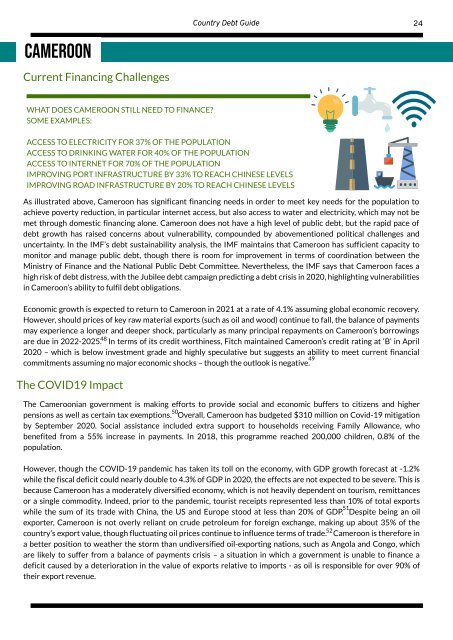You also want an ePaper? Increase the reach of your titles
YUMPU automatically turns print PDFs into web optimized ePapers that Google loves.
Country <strong>Debt</strong> <strong>Guide</strong><br />
24<br />
Cameroon<br />
Current Financing Challenges<br />
WHAT DOES CAMEROON STILL NEED TO FINANCE?<br />
SOME EXAMPLES:<br />
ACCESS TO ELECTRICITY FOR 37% OF THE POPULATION<br />
ACCESS TO DRINKING WATER FOR 40% OF THE POPULATION<br />
ACCESS TO INTERNET FOR 70% OF THE POPULATION<br />
IMPROVING PORT INFRASTRUCTURE BY 33% TO REACH CHINESE LEVELS<br />
IMPROVING ROAD INFRASTRUCTURE BY 20% TO REACH CHINESE LEVELS<br />
As illustrated above, Cameroon has significant financing needs in order to meet key needs for the population to<br />
achieve poverty reduction, in particular internet access, but also access to water and electricity, which may not be<br />
met through domestic financing alone. Cameroon does not have a high level of public debt, but the rapid pace of<br />
debt growth has raised concerns about vulnerability, compounded by abovementioned political challenges and<br />
uncertainty. In the IMF’s debt sustainability analysis, the IMF maintains that Cameroon has sufficient capacity to<br />
monitor and manage public debt, though there is room for improvement in terms of coordination between the<br />
Ministry of Finance and the National Public <strong>Debt</strong> Committee. Nevertheless, the IMF says that Cameroon faces a<br />
high risk of debt distress, with the Jubilee debt campaign predicting a debt crisis in 2020, highlighting vulnerabilities<br />
in Cameroon’s ability to fulfil debt obligations.<br />
Economic growth is expected to return to Cameroon in 2021 at a rate of 4.1% assuming global economic recovery.<br />
However, should prices of key raw material exports (such as oil and wood) continue to fall, the balance of payments<br />
may experience a longer and deeper shock, particularly as many principal repayments on Cameroon’s borrowings<br />
48<br />
are due in 2022-2025. In terms of its credit worthiness, Fitch maintained Cameroon’s credit rating at ‘B’ in April<br />
2020 – which is below investment grade and highly speculative but suggests an ability to meet current financial<br />
49<br />
commitments assuming no major economic shocks – though the outlook is negative.<br />
The COVID19 Impact<br />
The Cameroonian government is making efforts to provide social and economic buffers to citizens and higher<br />
50<br />
pensions as well as certain tax exemptions. Overall, Cameroon has budgeted $310 million on Covid-19 mitigation<br />
by September 2020. Social assistance included extra support to households receiving Family Allowance, who<br />
benefited from a 55% increase in payments. In 2018, this programme reached 200,000 children, 0.8% of the<br />
population.<br />
However, though the COVID-19 pandemic has taken its toll on the economy, with GDP growth forecast at -1.2%<br />
while the fiscal deficit could nearly double to 4.3% of GDP in 2020, the effects are not expected to be severe. This is<br />
because Cameroon has a moderately diversified economy, which is not heavily dependent on tourism, remittances<br />
or a single commodity. Indeed, prior to the pandemic, tourist receipts represented less than 10% of total exports<br />
51<br />
while the sum of its trade with China, the US and Europe stood at less than 20% of GDP. Despite being an oil<br />
exporter, Cameroon is not overly reliant on crude petroleum for foreign exchange, making up about 35% of the<br />
52<br />
country’s export value, though fluctuating oil prices continue to influence terms of trade. Cameroon is therefore in<br />
a better position to weather the storm than undiversified oil-exporting nations, such as Angola and Congo, which<br />
are likely to suffer from a balance of payments crisis – a situation in which a government is unable to finance a<br />
deficit caused by a deterioration in the value of exports relative to imports - as oil is responsible for over 90% of<br />
their export revenue.


